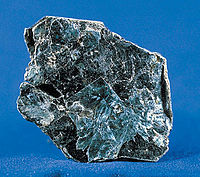
A sulfur-poor terrestrial core inferred from metal-silicate partitioning experiments
Sign Up to like & getrecommendations! Published in 2017 at "Earth and Planetary Science Letters"
DOI: 10.1016/j.epsl.2017.04.016
Abstract: Abstract As a siderophile and a volatile element, sulfur's partitioning behavior allows constraints to be placed on processes in the primitive Earth. Sulfur's core–mantle distribution during Earth's accretion has consequences for core content and implications… read more here.
Keywords: silicate partitioning; accretion; metal silicate; earth ... See more keywords

The effect of melt composition on metal-silicate partitioning of siderophile elements and constraints on core formation in the angrite parent body
Sign Up to like & getrecommendations! Published in 2017 at "Geochimica et Cosmochimica Acta"
DOI: 10.1016/j.gca.2017.05.034
Abstract: We present 275 new metal-silicate partition coefficients for P, S, V, Cr, Mn, Co, Ni, Ge, Mo, and W obtained at moderate P (1.5 GPa) and high T (1683–1883 K). We investigate the effect of silicate melt… read more here.
Keywords: silicate partitioning; silicate; metal silicate; melt composition ... See more keywords

Constraining compositional proxies for Earth’s accretion and core formation through high pressure and high temperature Zn and S metal-silicate partitioning
Sign Up to like & getrecommendations! Published in 2018 at "Geochimica et Cosmochimica Acta"
DOI: 10.1016/j.gca.2018.04.032
Abstract: Abstract Zinc is a moderately volatile and slightly siderophile element, and therefore provides information into the timing and conditions of volatile element delivery to Earth as well as the redistribution of these elements during planetary… read more here.
Keywords: silicate partitioning; metal silicate; formation; silicate ... See more keywords

Rice husks as a sustainable silica source for hierarchical flower-like metal silicate architectures assembled into ultrathin nanosheets for adsorption and catalysis.
Sign Up to like & getrecommendations! Published in 2017 at "Journal of hazardous materials"
DOI: 10.1016/j.jhazmat.2016.09.004
Abstract: Metal silicates have attracted extensive interests due to their unique structure and promising properties in adsorption and catalysis. However, their applications were hampered by the complex and expensive synthesis. In this paper, three-dimensional (3D) hierarchical… read more here.
Keywords: silicate; flower like; metal silicate; rice husks ... See more keywords

Confining Bimetal Sites in Porous Metal Silicate Materials for Aerobic Oxidation of Phenols under Mild Conditions.
Sign Up to like & getrecommendations! Published in 2023 at "Inorganic chemistry"
DOI: 10.1021/acs.inorgchem.2c03756
Abstract: Inspired by the unique catalytic properties of enzymes, numerous biomimetic catalysts have been developed with the intention to realize activation of unreactive reactants under mild conditions; however, the requirement of harsh activation conditions heavily deters… read more here.
Keywords: aerobic oxidation; metal silicate; oxidation phenols; mild conditions ... See more keywords

The Effects of Carbon Concentration and Silicate Composition on the Metal‐Silicate Partitioning of Carbon in a Shallow Magma Ocean
Sign Up to like & getrecommendations! Published in 2019 at "Geophysical Research Letters"
DOI: 10.1029/2019gl084254
Abstract: The partitioning of carbon between the core and mantle during the formation of terrestrial planets may have controlled the distribution of carbon in terrestrial planets. However, the abundance of carbon in the Earth's mantle is… read more here.
Keywords: silicate; metal silicate; silicate partitioning; carbon ... See more keywords

Reconciling metal–silicate partitioning and late accretion in the Earth
Sign Up to like & getrecommendations! Published in 2021 at "Nature Communications"
DOI: 10.1038/s41467-021-23137-5
Abstract: Highly siderophile elements (HSE), including platinum, provide powerful geochemical tools for studying planet formation. Late accretion of chondritic components to Earth after core formation has been invoked as the main source of mantle HSE. However,… read more here.
Keywords: platinum; silicate partitioning; metal silicate; formation ... See more keywords

Pressure, sulfur, and metal-silicate partitioning: The effect of sulfur species on the parameterization of experimental results
Sign Up to like & getrecommendations! Published in 2018 at "American Mineralogist"
DOI: 10.2138/am-2018-6282
Abstract: Abstract Performing well-controlled metal-silicate partitioning experiments at conditions directly simulating those of a deep magma ocean is difficult. It is therefore common to perform experiments at lower pressures and temperatures, which are used to determine… read more here.
Keywords: silicate partitioning; sulfur; relationship; metal silicate ... See more keywords